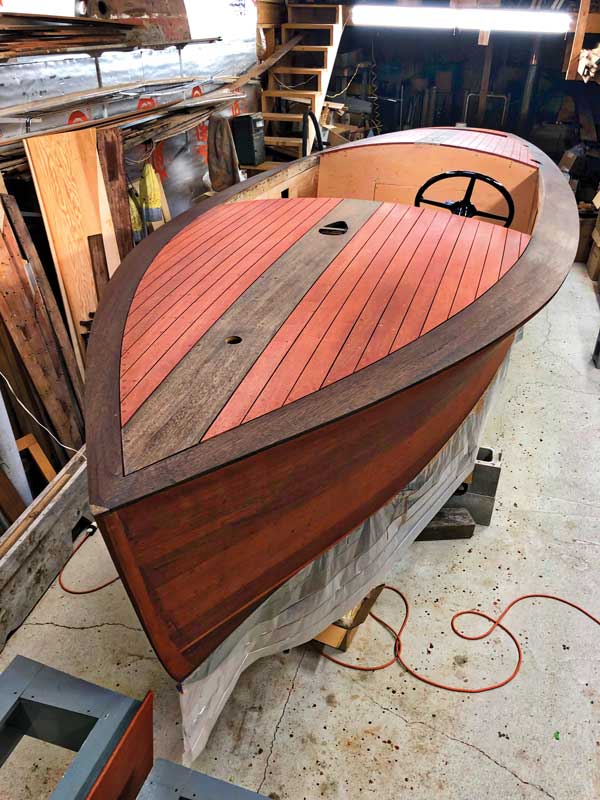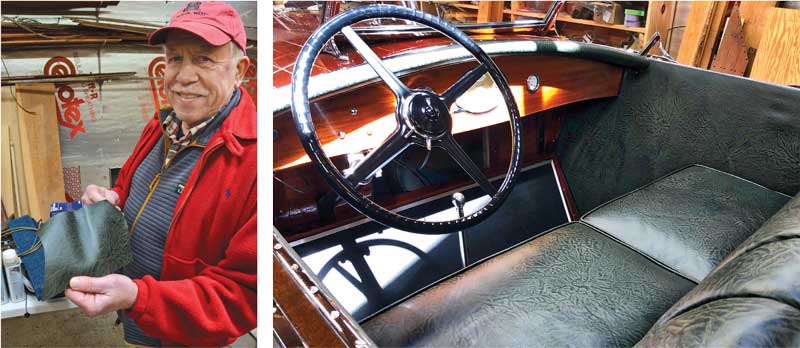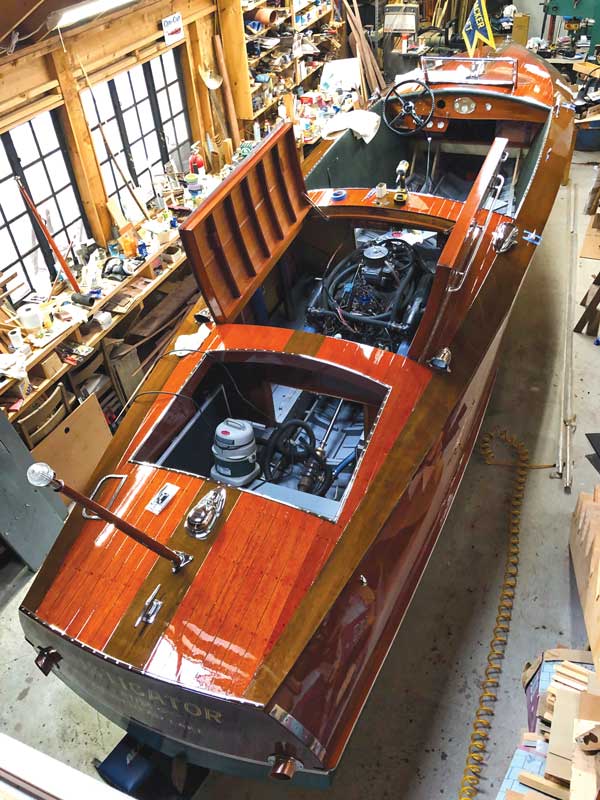 A half-dozen years shy of her 100th birthday, the newly restored triple cockpit Hacker-Craft runabout Rusticator Rum, at home on Moosehead Lake, looks like she was just launched on the Detroit River by her builder, the Hacker Boat Company. Photo courtesy Bob Bartlett
A half-dozen years shy of her 100th birthday, the newly restored triple cockpit Hacker-Craft runabout Rusticator Rum, at home on Moosehead Lake, looks like she was just launched on the Detroit River by her builder, the Hacker Boat Company. Photo courtesy Bob Bartlett
 In a shop located at the Bartlett Winery in Gouldsboro, the freshly planked hull of the Hacker-Craft runabout that will be rechristened Rusticator Rum awaits the next step in her 40-year restoration. Photo courtesy Bob BartlettIt’s the rare relationship that endures for 40 years, especially one that involves an old wooden runabout and a restorer for whom boats are just one of many fascinations. Even the mind-boggling restoration of the historic Swedish warship Vasa, sunk immediately after launching in 1628 and raised from the bottom of Stockholm harbor in 1962, was completed in less time. But then again, the naval vessel wasn’t a vintage Hacker, and the craftsman at work on her wasn’t Bob Bartlett.
In a shop located at the Bartlett Winery in Gouldsboro, the freshly planked hull of the Hacker-Craft runabout that will be rechristened Rusticator Rum awaits the next step in her 40-year restoration. Photo courtesy Bob BartlettIt’s the rare relationship that endures for 40 years, especially one that involves an old wooden runabout and a restorer for whom boats are just one of many fascinations. Even the mind-boggling restoration of the historic Swedish warship Vasa, sunk immediately after launching in 1628 and raised from the bottom of Stockholm harbor in 1962, was completed in less time. But then again, the naval vessel wasn’t a vintage Hacker, and the craftsman at work on her wasn’t Bob Bartlett.
Last summer, Bartlett, a vintner and spirits distiller, launched the 1929 Hacker triple cockpit runabout Rusticator Rum—also the trade-marked name for one of the spirits distilled at the Bartlett Winery in Gouldsboro—into the waters of Moosehead Lake in northern Maine. That event marked the conclusion of a restoration project that began more than 40 years earlier when Bartlett found the boat—or what was left of it—in Wolfeboro, New Hampshire.
The culmination of the project came a few weeks later, when Rusticator Rum won a gold medal—the second highest honor—for restoration of an antique runabout at the Antique and Classic Boat Society’s annual Vintage Boat Week show and celebration in Bay Harbor, Michigan.
“This is against professional restorers, you know,” Bartlett said recently. “So, I was pretty happy. I couldn’t get the platinum unless I had an original engine or an engine of that vintage. And that’s okay. I’m not crazy about medals and stuff. I just thought, you know, it’s done.”
 Two views of Bob Bartlett’s Hacker-Craft runabout restoration project show the boat being prepped for finishing. When he bought the boat it was a derelict, with oil-soaked bottom planking and many broken frames, which he replaced. Photo courtesy Bob Bartlett
Two views of Bob Bartlett’s Hacker-Craft runabout restoration project show the boat being prepped for finishing. When he bought the boat it was a derelict, with oil-soaked bottom planking and many broken frames, which he replaced. Photo courtesy Bob Bartlett  Photo courtesy Bob Bartlett
Photo courtesy Bob Bartlett
His sense of accomplishment is easy to understand, given Bartlett’s lifelong fascination with boats, especially the elegant, varnished mahogany runabouts designed by the naval architect John L. Hacker.
Founded in 1908, the Detroit-based Hacker Boat Co. was famous for its high-speed runabouts, commuter yachts, and racing boats. Hacker was credited with inventing the V-shaped hull form known as the “Hacker bottom” and, in 1911, the Hacker-Craft Kitty Hawk was the first boat known to exceed 50 knots.
In the years before the Great Depression, Hacker’s customers included the rich and famous—Henry Ford among them. Hacker’s 24-foot, triple cockpit runabouts were the sort of boat Jay Gatsby might have admired as he gazed across Long Island Sound. They certainly enticed Bartlett.
“Well, I grew up in Detroit, and I kind of remember either reading or hearing about Hacker,” Bartlett said. “I always liked wood boats too. My parents had a Lightning sailboat. It was wood, and I used to race that.”
Bartlett still has an as-yet-unrestored Lightning in the shed next to his boat shop at the winery, but he’s yet to work on that one.
“My parents had a cottage on Walloon Lake up by Petoskey [Michigan], and there were some old Chris-Crafts and Hackers up there. And I just always thought they were beautiful.”
 Vintner, distiller, and serial restorer of classic cars, motorcycles, and boats, Bob Bartlett holds a scrap of the custom-dyed leather used to upholster the cockpit. Photo of Bob Bartlett by Stephen Rappaport. Other photo courtesy Bob Bartlett
Vintner, distiller, and serial restorer of classic cars, motorcycles, and boats, Bob Bartlett holds a scrap of the custom-dyed leather used to upholster the cockpit. Photo of Bob Bartlett by Stephen Rappaport. Other photo courtesy Bob Bartlett
Around 1975, Bartlett and his wife, Kathe, bought land in Gouldsboro and began building what would become the winery, and more recently, the Bartlett Spirits of Maine Distillery. At the time, Bartlett was working as a glass artist, exhibiting his work in galleries in New York and Europe.
Beginning in 1978, he said, “I ran Ohio University’s glass program, and I taught design there and stuff.” But, he added, three years in academia was enough. The Bartletts moved to their land in Maine. Bob, already interested in winemaking, took some courses at Cornell and the University of California, Davis, and began producing high quality wines. The couple even grew their own grapes for a while. Then, an article in WoodenBoat magazine rekindled his interest in mahogany runabouts and Hacker-Craft boats in particular.
That was the beginning. The article led Bartlett to a man who later became his friend in Wolfeboro, who bought and sold old runabouts—not a high-volume business. “Nobody wanted them,” Bartlett said of those boats. “I mean, people were burning them, you know, getting rid of them.” But not Bartlett.
In 1975 he found a Hacker for sale on Verona Island, a 20-foot utility runabout. “So, I went over there, and the guy who owned it was tearing the thing apart,” Bartlett said. “He took the transom apart. He had a hole in it to put a sterndrive in.” The guy’s plan was to replace the original gasoline inboard engine and conventional shaft and propeller drive.
Bartlett rebuilt the transom, did considerable work on the hull, installed a Chrysler Crown gas engine like the one that originally powered the boat, then sold the whole shebang. A few years later, though, he bought the derelict Hacker that became Rusticator Rum from his pal up in New Hampshire.
“I’d seen a 24-foot Hacker, like a 1930, and I really liked the design. They’re pretty rare, maybe three or four in the world,” Bartlett said. He’d already told his New Hampshire buddy, “if you ever see one of them, let me know. I’ll buy it.” A year later, his friend called.
“So,” Bartlett said, “I go over there, and it’s a disgusting mess. And I’m kind of on the fence.” His friend told him if he didn’t want the boat there were plenty of other interested parties. “So, I said, OK, I’ll buy it and I hauled it back.”
At the winery, he flipped the boat upside down in the large shed that is his workshop. Then the fun began.
 Rusticator Rum, varnish gleaming, with engine and running gear installed, is almost ready to launch. Photo courtesy Bob Bartlett
Rusticator Rum, varnish gleaming, with engine and running gear installed, is almost ready to launch. Photo courtesy Bob Bartlett
First Bartlett stripped the original oil-soaked bottom planks from the boat and replaced them. He also replaced most of the frames; the side frames are original, but all the deck frames are new, and he completely re-planked the hull and deck. He already had on hand a supply of high-quality lumber he’d bought for another boat he’d planned to build. Instead, the book-matched African mahogany was used to restore the 24-footer. The hull and bottom are carvel planked, without visible seams, and finished with 12 coats of varnish.
In addition to rebuilding the hull and cockpit, Bartlett restored the boat’s chrome-plated hardware, all of it original except for the windshield frame, which is an exact replica. He acquired a half-dozen custom-dyed hides for the cockpit’s leather upholstery—a feature almost exclusive at the time to Hacker-Craft, and he repaired the boat’s antique Stewart-Warner engine gauges, including the rare, rotating drum-style tachometer used instead of the more common needle pointer type. A marinized 325-hp gas engine, equipped with a custom-built mechanical drive for the tachometer, was installed in the boat just in time for a test run on Moosehead last summer before it was towed on a custom trailer to the ACBS boat show, something Bartlett said was “on my bucket list.”
 Bob Bartlett with a yet-to-be-restored Lightning sailboat, like the one he learned to sail in as a boy in Michigan. Photo by Stephen Rappaport
Bob Bartlett with a yet-to-be-restored Lightning sailboat, like the one he learned to sail in as a boy in Michigan. Photo by Stephen Rappaport
Forty years, more or less, is a long time to restore a boat. Bartlett did almost all the work himself—his wife Kathe pitched in with sanding and varnishing and other bits and pieces from time to time, a professional did the leather cockpit upholstery except for the bolsters, which Bartlett did himself, and a professional shop in Massachusetts re-chromed the hardware—but it was hardly a full-time project. Bartlett built a successful, highly regarded winery and distillery in a most unlikely location—he designed and built the building as well as the business—and, in his “spare time,” restored several classic automobiles and motorcycles.
For the moment, Rusticator Rum is afloat at the Bartlett’s home on Moosehead Lake, and, in addition to that unrestored Lightning, Bartlett also has what he believes is the first motor launch—built around 1926—used by the Maine Warden Service on Moosehead Lake, in his shed. Perhaps one of them will be the next project.
✮
Stephen Rappaport is a writer and editor. He has lived in Maine for more than 35 years, and is a lifelong sailor.






